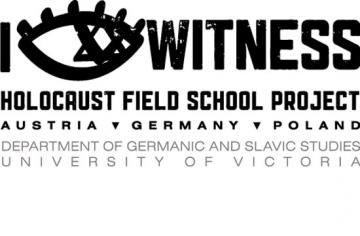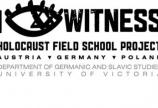Student I-witness Blog--Holocaust Field School
- Tara Sharpe

What follows are excerpts from the student blog for the inaugural I-witness Holocaust Field School, which took place in Central Europe from May 8 to 28, 2011. The field school was launched by the Department of Germanic and Slavic Studies this year, and is the only course of its kind being offered to undergraduate students at a Canadian university.
Click here for a special visual essay of the sites described below and click here for a related article including photos of the same.
Berlin, Day 4
May 10 by Liam O'Reilly
"The [Memorial to the Murdered Jews of Europe] memorial is a large field of standing concrete blocks set on rolling hills in a grid pattern. It does not prescribe a meaning, but rather is self-reflective. Many were confused, some were somewhat affected, while others were emotional in response. But, and I feel quite safe saying this, there was no indifference: we liked, disliked, or were confused by the memorial. This is not a monument one easily forgets or shrugs off. Upon reflection, what I have written here may seem we are on a journey of futility. But I don't believe this is the case. The fact that such spirited discussion and confusion occurred seems to be the point."
Auschwitz-Birkenau (Poland), Day 10
May 16 by Brooke Brassard
"The group discussed visits to former concentration camps Sachsenhausen and Ravensbr&u#168;ck during the bus ride. Desensitization is a shared struggle throughout the group due to our academic focus on the Holocaust. We discussed the difficulty of experiencing both emotional and academic perspectives. Personally, I feel not only desensitized, but also frustrated because there are no logical explanations for the atrocities we face throughout this field school. We arrived at Auschwitz around 10 am. The first things I noticed were beautiful brick buildings; green, manicured lawns; and, a quiet, calm atmosphere. This was not what I imagined Auschwitz to be like. Only seventy years separate us from World War II, but the current appearance of Auschwitz makes it seem more like hundreds of years since the concentration camp was in use…
"Our tour guide introduced the site only steps away from the famous sign: Arbeit macht frei.…In Block 5, suitcases, shoe polish cans, and children's clothes are only some of the physical evidence on display. The Auschwitz Museum utilizes visual representation throughout. We came across many SS photographs, prisoner mug shots, uniforms, and reconstructions of prisoner bunks…In the lower level [of Block 11], the cellar, are rooms for prisoners sentenced to death by starvation…I experienced a startling moment when I attempted to leave the lower level, but was unable to exit as another large group was coming down the narrow staircase. It was poorly lit and chilly down in the cellar; being unable to leave caused a sense of powerlessness and slight panic. This feeling was incomparable to what actual prisoners felt during their time in Auschwitz and in this very jail. I was not forced to st#8743; I was not alone, or in complete darkness."
After Auschwitz
May 16 by Andrea Van Noord
"I am disturbed by the apparent ease with which we transition from the Holocaust to hockey and I am embarrassed by our collective lack of patience. To walk three hours or to stand still for fifteen minutes means nothing in the face of six million. And yet, I am even tired of the number, the vast unknowable number which does not include everyone. So why am I here? Why are we here?
"...I took two steps into [the Jewish Museum] and felt ill, disoriented and small. I had that same feeling today ascending the steps at Auschwitz towards a room filled with two tons of hair…We must stop venerating the objects because one day they will no longer exist, just as we must teach ourselves to speak on behalf of survivors who will not be with us much longer. One day there will be no more 'proof.' We will be left with abstract, post-modernist conceptions, empty chairs and concrete spaces, mere traces that will themselves one day erode leaving mythical and mysterious ruins…
"What will we do? This is the question, these are the issues that I want to address."
Mauthausen (Austria), Day 13
May 19 by Cam Robinson
"At first glance it was plain to see the area held a natural beauty that transcended across the rural expanse. The close proximity to the surrounding homes made it clear that those who had lived there had likely known quite well the actions of the prison that stood above them as an ever-present reminder of the strength of the occupying power. Our guide was quick to point out the soccer field that sat at the front steps of the camp, and discussed the lesser known facts of local teams participating in matches against the SS at the location. The field would later become home to a mass grave for some of the estimated 100,000 victims.
"…Many of us decided to walk down the 186 "Stairs of Death" which led to the all-important granite quarry. The walk down produced a severe feeling of vertigo as you tried not to fall forward…We finished the visit by walking each step back to the top. As unimaginable as camp life is to a non-survivor, the walk up those steps in the midday heat gave a miniscule glimpse into what a Mauthausen prisoner may have felt. It was the first time I actually felt a connection to a camp and it was quite moving. The Mauthausen Camp was one of great tragedy and severe conditions despite its location amongst some of the most serene landscapes of Austria."
Schloß Hartheim (Austria), Day 13
May 19 by Erin O'Brien
"During the 1940s in the midst of WWII, the Nazis used the scenic [Schloß Hartheim] castle as a site for their T4 euthanasia program where over 30,000 'challenged' people were murdered in the gas chambers…Unlike Mauthausen and the other camps the activities of Hartheim were kept well under wraps as it was viewed as the outright murder of innocent people and that could be classified as nothing but murder in the first degree. We learned that the local people expressed upset at the sight of hundreds of people coming in to the castle by large buses and not one of them leaving; this ultimately led to changes in the Nazis' plans.
"The T4 program ended in 1941 and yet the euthanasia continued well into 1944…We walked into a room with shelves with mugs, cups and other minor items, followed by a room with lists upon lists of names in no particular order. Those mugs belonged to the victims, the room with the names was the processing room where patients were stripped before going into the gas chamber. The lists were the names of over 23,000 victims randomized so they would not have their memory live in an alphabetical list, they had spent their entire lives on lists such as that. The mugs had been buried in a cement block that was actually made from the patients' ashes when the Nazis stopped throwing the ashes into the Danube."
Berlin, Day 17
May 23 by Harji Sidhu
"A glass covered cube stood kitty-corner to the first Servitengasse memorial. Underneath the glass were numerous old-fashioned keys. Each of the keys was labelled with the name of a resident of Servitengasse. Although families lived together…the designer of this memorial purposely scattered family members' keys apart from each other to represent how families were torn apart during the evacuation process. After seeing large memorials throughout Germany, Poland, and Austria I found it very humbling to see this smaller memorial."
Postscripts
May 31 by Lauren Micaela Petersen
"We've already established that monuments serve not only as a commemoration of a certain event-in most cases the monument itself serves as a window into the time of its creation! This draws us back to the question of how does one memorialize appropriately? Who is responsible for determining what to memorialize, how to memorialize? When it comes to the Holocaust-approximately 11,000,000 lives were lost…the world changed forever! How do we ensure everyone is properly represented? Whose responsibility is it to foot the bill?
"...Later in the afternoon [of Day 20, May 26] after a short break for lunch our team headed over to the [Memorial to homosexuals persecuted under Nazism, in Berlin]. The memorial itself is located across the street from the memorial for murdered Jews. It is stationed on an angle compared to the rest, and as you approach you can see there is a film playing inside a little window. The closer you get the more clearly you can see a black and white film of a same sex couple enjoying a quiet intimate moment together, sheltered by the lush trees of the park… The kiss, something so simple, is symbolic of the fear that crept into the lives of homosexuals living within the Reich. It is a mere historical detail-a kiss, a touch, a look…any gossip of such was enough to bring about arrest and imprisonment…
"I-Witness does not stop here, because we will all, without a doubt, carry these experiences in our hearts forever."
June 1 by Ryan Severyn
"I was struck by the beauty of the wealthy lakeside community of Wannsee [of Day 21, May 27], home of the quaint private mansion that hosted the meeting of 15 Nazi dignitaries and officials who, under the command of Reinhard Heydrich, over breakfast decided on the Nazi 'final solution' for the Jews on Jan. 20, 1942.
"…and it was not the only place that I experienced the strange dichotomy of these sites of death being surrounded by such natural beauty. Ravensbr&u#168;ck by the lake, Mauthausen, the grassy hills and now…standing in front of this beautiful home I am struck by the sick binary comprised in these sites."

